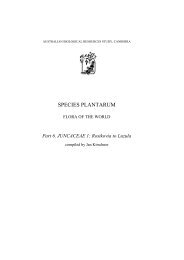Part 7. JUNCACEAE 2: Juncus - Species Plantarum Programme
Part 7. JUNCACEAE 2: Juncus - Species Plantarum Programme
Part 7. JUNCACEAE 2: Juncus - Species Plantarum Programme
You also want an ePaper? Increase the reach of your titles
YUMPU automatically turns print PDFs into web optimized ePapers that Google loves.
34<br />
SPECIES PLANTARUM — FLORA OF THE WORLD (2002)<br />
Confined to, and widely distributed in, S and E South Africa from SW Cape to Transvaal.<br />
Naturalised in the North Island of New Zealand. 27: CPP, LES, NAT, SWZ, TVL. 51: nzn.<br />
A wide range of wet habitats from sea level to the mountains, mostly along streams and in<br />
seepage areas. Map 190.<br />
2<strong>7.</strong> CAPE PROVINCES: Amabela, M. de Vries 2601 (LD); Uitenhaag, Zwartkopsrivier, C.F.Ecklon &<br />
C.Zeyher 13 (LD); 799 (S); Port Elizabeth, Winterhoek Mtns, T.C.E.Fries, T.Norlindh & H.Weimarck 811,<br />
874, 875 (LD); Fraserburg, Layton, J.P.H.Acocks 23534 (K); Stellenbosch, Firgrove, R.S.Adamson 129, 137<br />
(BOL). LESOTHO: Sehlabathebe, Tsoelikana Valley, F.K.Hoener 2152 (K). NATAL: Port Shepstone,<br />
C.J.Ward 5209 (K, PRE); Clairwood, Durban, R.E.Fries & T.C.E.Fries 3137 (LD). TRANSVAAL:<br />
Lydenburg, Lisabon State Forest, C.Reid 823 (K, PRE).<br />
The type of J. diaphanus, the H.Bolus 188* specimen, evidently a (major) part of the<br />
holotype, annotated by Buchenau before the time of publication of his study (1875),<br />
originally in herb. O.W.Sonder, nowadays in S, in all likelihood represents a pallid,<br />
hexandrous, ±broad-leaved <strong>Juncus</strong> dregeanus. The plant may well be perennial, although its<br />
base is more slender than in the typical form. In its general habit, it also approaches plants<br />
described as J. sonderianus. Another rather aberrant form was described as J. mollifolius.<br />
It differs in its flaccid leaves and slender stems and, most notably, in a more loosely<br />
caespitose growth; in all the more substantial characters it is identical with J. dregeanus<br />
s. str., only the seed size is at the upper limit. It might represent a third subspecies of<br />
J. dregeanus but further study is needed.<br />
13b. <strong>Juncus</strong> dregeanus subsp. bachitii (Steud.) Hedberg, Symb. Bot. Upsal. 15(1):<br />
61 (1957)<br />
<strong>Juncus</strong> bachitii Hochst. ex Steud., Syn. Pl. Glumac. 2: 305 (1855). T: 'Abyssin.' [Ethiopia, Tigre Province],<br />
Mt Bachit, 11000 ft., Schimper 114; holo: P, n.v.; iso: PRE, W.<br />
Illustrations: S.Carter, in E.Milne-Redhead & R.M.Polhill Fl. Trop. E. Africa, Juncaceae 5, fig. 1 (1966);<br />
K.A.Lye, in S.Edwards, Sebsebe D. & I.Hedberg, Fl. Ethiop. Eritr. 6: 388, fig. 211.1 (1997).<br />
Capitulum bracts brownish. Tepals blackish brown to dark brown. Stamens 6. Seeds<br />
0.35–0.55 mm long. 2n = c.40, fide I.Hedberg & O.Hedberg, Bot. Not. 130: 11 (1977). Fig. 50.<br />
In the mountains of the NE, E, and W-C parts of South Tropical Africa. 23: CMN, RWA,<br />
ZAI. 24: ETH, SUD. 25: KEN, TAN, UGA. 26: MLW, ZAM, ZIM. In marshes and along<br />
streams, mainly in mountain forests, rarely in wet alpine grasslands, usually above 2000 m.<br />
Map 191.<br />
23. CAMEROON: Bamenda Highlands, Mt Oku, 2900 m, I.Fokom 141 (K). ZAIRE: Karisimbi, 3300 m,<br />
J.-H.Humbert 8588 (P). RWANDA: Karisimbi, Visoke saddle, Hagenia Zone, W.D'Arcy 7563 (CHR, MO,<br />
n.v., NSW). 25. KENYA: Mt Elgon, 3800 m, H.Granvik 140 (LD); Mt Kenya, 3125 m, O.Hedberg 2005<br />
(LD); Aberdare Range, W part of the Nyeri track, 3070 m, O.Hedberg 1599 (LD). TANZANIA:<br />
Kilimanjaro, 2700 m, Volkens 1309 (BM, K). UGANDA: Ruwenzori, Mobuku Valley, 3250 m, O.Hedberg<br />
752 (LD); Muhavura – Mgahinda saddle, 3050 m, Purseglove 2205 (K). 26. ZIMBABWE: Inyanga,<br />
Niarerua Ck, c. 1700 m, T.C.E.Fries, T.Norlindh & H.Weimarck 2407 (LD); Mare Dam in Nyanga Park,<br />
2000 m, S.Laegaard 16038 (LD).<br />
Plants from the southernmost part of the subspecies' range usually have slightly paler<br />
perianth; otherwise they correspond to the typical plants from the north.<br />
14. <strong>Juncus</strong> sonderianus Buchenau, Monogr. Junc. Cap 476 (1875) [Abh. Naturwiss.<br />
Ver. Bremen 4: 476 (1875)]<br />
T: [Cape] Port Elizabeth, J.F.Drège e; syn: G, K, LD, P, W ['J.F.Drège e' was generally proposed as a type by<br />
Adamson, J. Linn. Soc., Bot. 50: 26 (1935)]; [Cape] bei Cap Recief und Port Elizabeth, C.F.Ecklon &<br />
C.Zeyher 9; syn: BOL, W, S; C.F.Ecklon & C.Zeyher 780; syn: n.v.<br />
Illustration: F.G.P.Buchenau, Monogr. Junc. Cap pl. 10 (1875).<br />
Map: H.Weimarck, Svensk Bot. Tidskr. 40: 160, fig. 8 (1946).<br />
Perennials, 11–35 cm tall, caespitose; rhizome shortly ascending, many-headed; stolons absent.<br />
Leaves basal and subbasal (densely inserted to 5 cm up the stem), mid-green to pale green,<br />
5–17 cm long, c. (1.5–) 2–5 (–7) mm wide; margins partly hyaline-bordered; apex acute;












